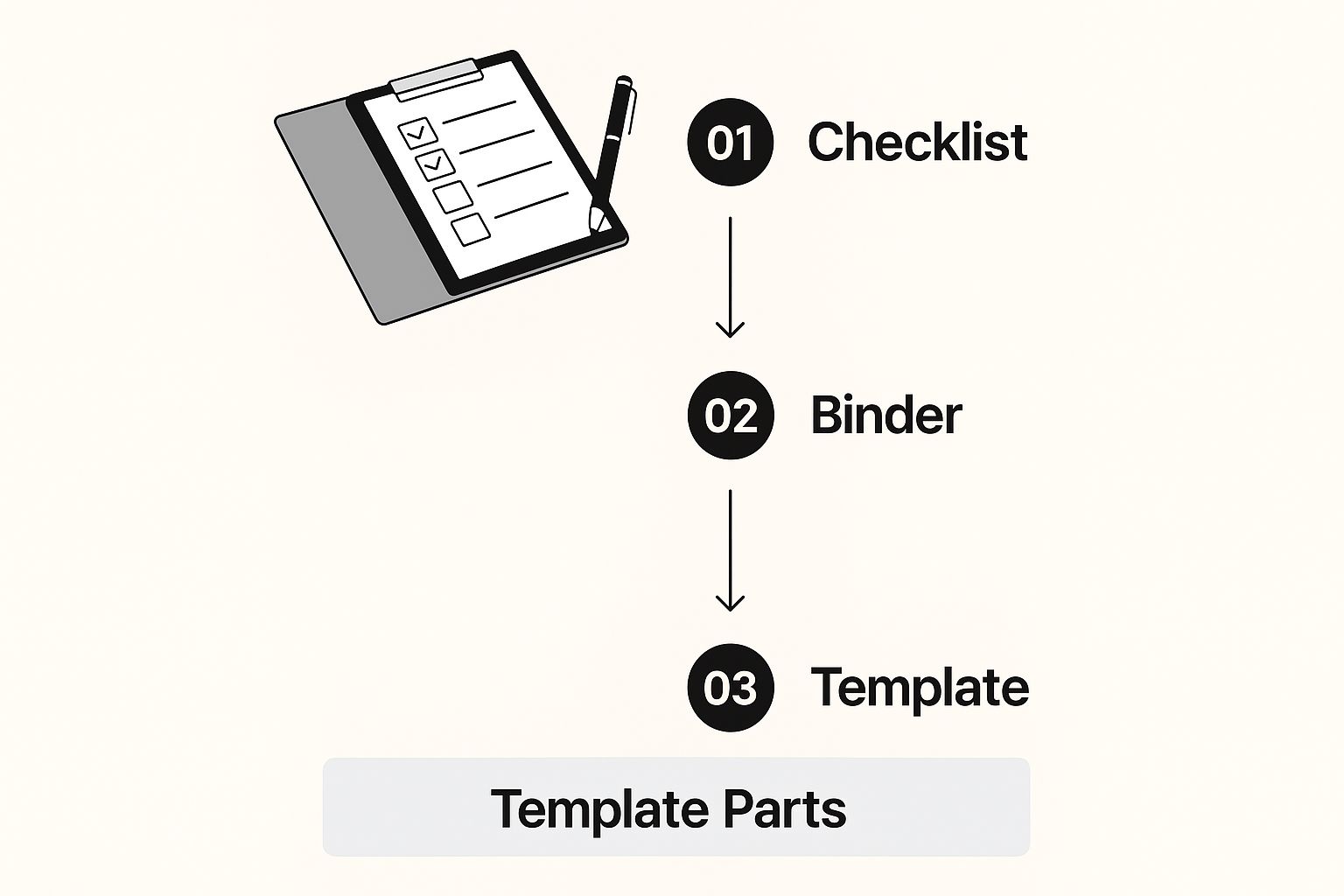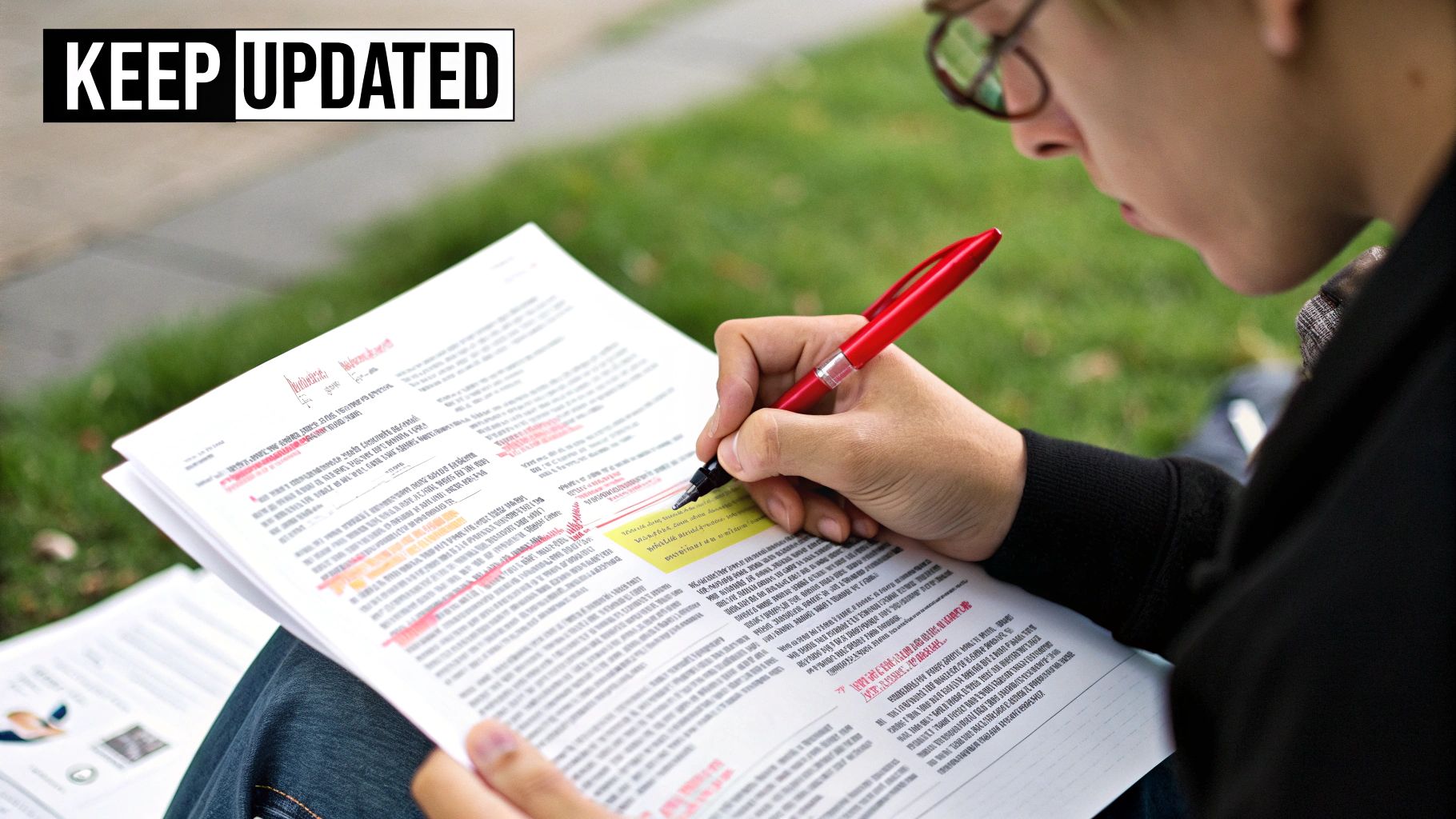A Simple SOP Template for Graduate School
- Matthew Amann

- Jul 13, 2025
- 11 min read
Let's be honest, staring at a blank document trying to write your Statement of Purpose can feel paralyzing. Where do you even start? This is exactly where a simple SOP template becomes your secret weapon. It’s not about taking a shortcut; it's about giving your powerful story the clear, organized structure it deserves.
The Strategic Advantage of a Simple SOP Template

The single biggest benefit of using a template is that it instantly gives you a roadmap. Instead of agonizing over the opening sentence, you have a blueprint that guides you from your introduction all the way to your final, impactful conclusion. This structure is your safety net, ensuring you hit all the key points the admissions committee is actively looking for.
Think of it from their perspective. When they see a well-organized narrative, it immediately tells them you're a serious candidate. You can organize your thoughts, present a logical case, and respect their time. That kind of clarity is far more persuasive than flowery, complex language that might actually hide your key qualifications.
Building a Focused and Clear Narrative
A good template forces you to break down your story into manageable sections, which is the key to a focused essay. This compartmentalized approach helps you dedicate the right amount of space to the most important parts of your application:
Your "Why": What’s driving you toward this specific field and, more importantly, this particular program?
Your Journey So Far: What key academic, professional, or personal experiences have prepared you for this next chapter?
Your Vision for the Future: How is this degree the critical next step in achieving your long-term goals?
This method keeps your story tight and prevents you from rambling, which is crucial for keeping a busy reader engaged. And it works. From what I've seen, there's a clear pattern: successful applicants almost always present a clear, structured argument. In fact, an estimated 70% of admitted students use a straightforward format that logically connects their past experiences, current motivations, and future ambitions.
A great SOP template isn’t a script to be copied. It’s a scaffold that supports your unique story, helping you build a powerful, coherent argument for why you belong in their program.
Interestingly, this principle of using a solid framework for clarity extends beyond admissions essays. For example, a good software documentation template does the same thing for technical writing—it creates consistency and makes complex information easy to understand.
Building Your Narrative with the SOP Template
Okay, you've got the basic structure down. Now for the fun part: turning that simple SOP template into a narrative that truly tells your story. This isn't just about listing your achievements; it's about weaving your past experiences and future goals into a convincing story for the admissions committee. Think of each section of the template as a chapter, all building up to one persuasive conclusion: you're the right fit for this program.
A Statement of Purpose, or SOP, is your chance to give context to your application. It’s where you go beyond the numbers and transcripts. The best ones I've seen usually start with a powerful introduction, touch on relevant academic or professional history, and then clearly connect the dots to why this specific program is the next logical step.
Crafting a Memorable Introduction
Your first paragraph is your first impression. Make it count. Skip the bland, "I am writing to apply for the Ph.D. program," and jump right in with something that grabs their attention. A compelling anecdote or a bold statement about your motivation works wonders.
Think about it: what was the lightbulb moment that set you on this path? Maybe it was a tough project at work, a professor who changed your perspective, or a problem you just couldn't stop thinking about. That's your hook. It immediately engages the reader and sets the stage for the rest of your essay.
My Two Cents: Treat your introduction like a thesis for your entire SOP. It should give a quick preview of the main points you'll cover—your passion, your background, and your ambitions. This gives the committee a clear roadmap of where you're taking them.
This visual breaks down how to use a template to construct a powerful narrative.

Connecting Past Experiences to Future Goals
The main body of your SOP is where you lay out the proof. It’s one thing to say you have a certain skill, but it’s much more powerful to show it. For every claim you make, offer a concrete example. Don't just tell them you're a skilled researcher; walk them through a project you managed, the hurdles you faced, and the insights you gained.
Academic Background: Instead of just listing courses from your transcript, talk about a specific paper or project that lit a fire in you. What was it about that particular topic that solidified your interest in this field?
Professional Experience: Frame your job duties as direct preparation for graduate studies. Did you lead a team? Analyze complex data? Develop a new workflow? Show how those experiences gave you the skills you need to succeed in their program.
The goal here is to build a clear, logical bridge from where you've been to where you want to go. It’s about showing that this program isn't just a random wish, but a deliberate and well-thought-out next step in your journey. Interestingly, this same principle of connecting steps logically is vital in the business world, too. If that's a world you're familiar with, you might find our guide on creating a business process documentation template shows a similar way of thinking.
From Template to Trademark: Making Your SOPs Truly Your Own

A template is a fantastic starting point. It gives you a solid skeleton, but it’s your job to add the muscle and personality. The real value emerges when you start weaving your company's specific context and voice into that framework. This is how a bland list of instructions becomes a document that genuinely reflects how your team gets things done.
You're aiming to translate vague statements into sharp, personalized instructions that actually click with your team. "Update the CRM" is generic. A great SOP says, "After every client call, update the 'Last Contacted' and 'Next Steps' fields in Salesforce to ensure the whole team has real-time visibility." See the difference? Your goal is to make your SOP unmistakably yours.
Let Your Company's Personality Shine Through
Every workplace has its own vibe and vocabulary. Let that come through in your writing! Using the language your team uses every day isn't just about being informal; it's about being clear and relatable. An SOP that sounds like it was written by a real person in your office—not a legal department—is far more likely to be read, understood, and followed.
To really elevate your draft, you need to bring in fresh perspectives. If you're looking for ways to spark creativity and generate innovative ideas, you'll find some great strategies that apply here, too.
In a competitive world, effective operational guides are no longer a "nice-to-have." In fact, about 85% of managers believe that well-defined SOPs are just as critical to team performance as core skills are. This is why a simple, clear SOP template can be so powerful, often cutting documentation time by 30-40%.
A great SOP doesn’t just list steps. It tells the story of how your team achieves excellence. It explains the 'why' behind the 'what,' which turns a simple checklist into a powerful tool for building consistency and quality.
This idea of documenting the "why" is also directly linked to performance. When procedures are crystal clear, it’s much easier to see results. For a deeper dive, check out our guide on how to measure employee productivity effectively.
Avoiding Common Pitfalls of SOP Templates
Even the most well-designed SOP template can lead you astray if you're not careful. The biggest trap I see people fall into is treating a template like a simple worksheet. They just fill in the blanks, and what they end up with is a generic, robotic document that doesn't actually help anyone. It’s a classic case of rushing the process and choosing speed over substance.
Another common mistake is failing to customize the template for its specific audience. You can't use the same tone and terminology for every single process. Think about it: an SOP for your sales team will—and should—feel completely different from one meant for your IT department. Their daily realities, their goals, and the challenges they face are worlds apart.
A template is your starting point, not your destination. The biggest error is assuming the structure alone is enough. True value comes from infusing the template with your team's specific knowledge, voice, and operational reality.
Moving from Generic to Genuine
So, how do you avoid these traps? You have to get your hands dirty and actively personalize the content. This means swapping out all the placeholder text for concrete examples that resonate with your team. Instead of a vague instruction like, "Update customer records," get specific. Explain exactly which fields in your CRM need to be updated and, crucially, why that step matters.
Here are a few classic vague phrases I always recommend cutting from your SOPs:
"As needed" or "When necessary": This is way too ambiguous. What does "as needed" actually mean? Define the precise triggers that should kick off an action.
"Follow company policy": Don't make people hunt for it. Link directly to the specific policy you're referring to. No more guesswork.
Generic role titles: Who is "the user"? Be specific. Use real job titles like "Account Manager" or "Support Specialist" to assign clear ownership.
This kind of detail is what separates a good SOP from a great one. It’s a core element of effective process design. In fact, many businesses are finding huge boosts in productivity by documenting and automating their workflows with this level of clarity. You can check out some top business process automation examples to see just how much of an impact clear, step-by-step processes can have.
Ultimately, your goal is to create an SOP that feels like it was written by someone who actually does the job every day.
Your Final Pre-Submission Review Checklist
You've done the hard work. You've poured your experiences, ambitions, and personality into the SOP template, and you finally have a complete draft. But before you even think about hitting that submit button, it's time to switch gears from writer to ruthless editor.
This final review is more than just a quick scan for typos. It's your last chance to make sure your story lands with the impact it deserves. Think of it as your application's pre-flight check—a methodical process to ensure every single sentence is pulling its weight and moving you closer to your goal.
My Go-To Pro Tip: Always, always read your entire SOP out loud. It’s a game-changer. This simple trick is the fastest way to find awkward phrasing, clunky sentences, and spots where your tone just feels off. If it sounds weird when you say it, it will definitely read weird to an admissions officer.
Key Areas for Your Self-Audit
To make this final pass effective, you need to be systematic. I find it helps to break the review down into four distinct areas. As you read, ask yourself these questions for each one:
Narrative Cohesion: Does my story make sense? Is there a clear, logical thread connecting my past experiences to my future ambitions at this specific university? You're looking for a smooth, compelling arc, not just a list of accomplishments.
Program Specificity: Have I made it crystal clear why I want to attend this program? Go beyond generic compliments. You should have mentioned specific professors you want to work with, unique courses that excite you, or research labs that perfectly align with your goals. The committee should feel like this SOP was written exclusively for them.
Authenticity and Voice: Does this actually sound like me? It's so easy to fall into the trap of using clichés or academic jargon you think they want to hear. Shave those away. Your genuine passion and unique voice are far more powerful.
Technical Polish: Is it perfect? I mean, really perfect. Check for grammar, spelling, and punctuation errors with a fine-tooth comb. Ensure the formatting is clean, professional, and easy on the eyes. Little mistakes can signal a lack of attention to detail.
To help you stay organized during this crucial final step, I've put together a simple checklist. Go through it point by point to ensure you haven't missed a thing. This is your final quality control before sending your story out into the world.
The Ultimate SOP Pre-Flight Checklist
Use this checklist to ensure your Statement of Purpose is compelling, polished, and ready for submission.
Review Area | Checklist Question | Complete (Yes/No) |
|---|---|---|
Overall Impression | Does the opening sentence immediately grab the reader's attention? | |
Is the closing paragraph memorable and confident? | ||
Clarity & Flow | Is there a clear, logical progression of ideas from start to finish? | |
Have I removed all jargon and overly complex sentences? | ||
Specificity | Have I named 2-3 specific faculty members, courses, or labs? | |
Do I clearly explain why those specific elements are a perfect match? | ||
Personal Voice | Does the SOP sound authentic and reflect my personality? | |
Have I shared a brief, relevant personal story or motivation? | ||
Proofreading | Have I read the entire SOP out loud to catch awkward phrasing? | |
Has someone else (a professor, mentor, or friend) proofread it? | ||
Is the document 100% free of spelling and grammar errors? | ||
Formatting | Does it meet the program's specified length and formatting rules? |
Once you can confidently answer "Yes" to every question on this list, you can feel great about your submission. You've done the work, and your SOP is ready to make a powerful impression. Good luck
Your Top SOP Questions, Answered
Even with a solid template in hand, a few tricky questions can come up as you’re putting the finishing touches on your Statement of Purpose. Let's walk through some of the most common ones I hear from applicants so you can feel completely confident when you hit "submit."
How Do I Handle a Low GPA or a Gap Year?
The trick here is to take ownership, not make excuses. You absolutely should address these things, but do it head-on and briefly, always framing them as opportunities for growth.
If you're worried about a less-than-perfect GPA, you could point to a specific tough semester where you had to learn critical time management skills. Then, show how that experience led directly to a much stronger academic performance later on. It's about demonstrating resilience.
A gap year can actually be a huge advantage. Don't hide it—highlight it! Explain how that time, whether you were working, traveling, or focusing on personal projects, cemented your decision to pursue this field. It shows a level of maturity and focus that admissions committees love to see.
Should I Get Creative With the Format?
Honestly, probably not. Unless you're applying to a highly creative program like an MFA in visual arts, it's almost always better to stick with a clean, professional format.
Think about it from their perspective: admissions officers are sifting through hundreds, sometimes thousands, of applications. A document that's easy to read and follows a familiar structure is a breath of fresh air. It shows respect for their time and proves you can communicate complex ideas clearly and professionally. Using a simple sop template ensures your qualifications are the star of the show, not your funky font choices.
Is It Better to Sound Humble or Confident?
You need to find that sweet spot right in the middle: confident humility. You have to be your own biggest advocate, but without tipping over into arrogance.
Instead of just stating, "I'm an excellent researcher," describe a specific research project you managed and the results you achieved. Let your accomplishments build the case for you.
Present your achievements and their outcomes with confidence. At the same time, frame your goals and desire to learn within the program with genuine humility. This combination shows you're self-aware and truly ready for the rigors of graduate-level work.
For a wider look at questions people have when getting help with important application documents, this resource covering common questions about professional document writing services can be quite helpful.
At Flow Genius, we specialize in turning complex processes into simple, effective workflows. If you're ready to eliminate manual tasks and boost your team's productivity, explore our smart automation services at https://www.flowgenius.ai.

Comments